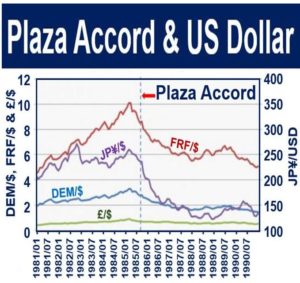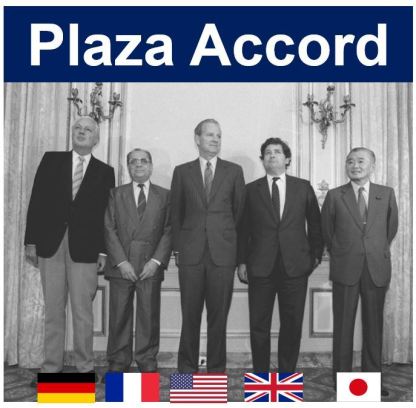Plaza Accord History
It all happened in the year 1985, in New York City, an agreement was signed.
This agreement was known as the plaza accord. It was named after a popular New York City hotel, which happens to be the venue of the meeting.
This meeting intended to rectify the trade imbalance between Germany, Japan, and the United States.
What is the Plaza Accord 1985
It is an agreement signed by G5 nations and represented by their finance ministers.
The G5 nations who signed this agreement were the United Kingdom, West Germany, United States, Japan, and France.
This agreement was signed on 22nd September 1985, at the plaza hotel, which is located in New York.
The G5 nations, which at that time were the largest economies in the world, made some pledges on their economic policies.
Terms and Conditions in Plaza Agreement
In this agreement, the five largest economies at that time agreed to some specific terms and conditions.
These terms and conditions were mainly on economic policies. Japan agreed to loosen its monetary policy.
That’s not all…
Because the United States gross domestic product has reached 3.5%, they promised to reduce their federal deficit.
Germany was not left out, and it also promises to implement some tax cuts.
It’s also important to remember that not all the G5 nations fulfilled their promise.
Objective of Plaza Agreement
The main objective of this accord was that all the G5 nations would intervene in the currency market.
This intervention is to push down the US dollar.
Because not all the nations kept their promise, the federal deficit of the United States of America was never cut.
Hence this agreement turned out to be a fantastic success.
Shifting of Plaza Accord to Louvre Accord
In 1987 a second agreement was signed, and it was known as the louvre accord.
The agreement was to stop the continuing decline of the US dollar.
Effect of the Plaza Accord on Japan
The plaza accord helped to solidify Japan in the international market. These made Japan become a significant player.
These led to japan’s economy into recessionary pressure. A strong yen led Japan to have an expansionary monetary policy.
Because of that, Japan’s economic experience a long period of slow deflation and growth.
Conclusion
The plaza agreement may have helped to propagate Japan. But the agreement failed to help the US in trade deficit reduction with Japan.
For the US, it helps to reduce its deficit with other nations.





